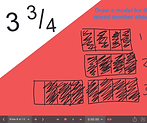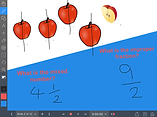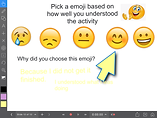Emma Rayner
Teaching Portfolio

Professional Knowledge
Fractions Learning Program
Annotations - Differentiation
Description
One of the learning programs that I developed as part of my placement was on fractions. Because students in the 3/4 classes were working at such a broad range of levels it was necessary to differentiate student learning to cater for all students’ needs. This is shown on the fractions learning program attached where student’s independent activity is divided into three groups.
VIT Standard
-
1.1 Physical, social and intellectual development and characteristics of students, Use teaching strategies based on knowledge of student’ physical, social and intellectual development and characteristics to improve student learning.
-
1.2 Understand how students learn, structure teaching using research and collegial advice about how students learn.
-
1.5 Differentiate teaching to meet the specific learning needs of students across the full range of abilities, Develop teaching activities that incorporate differentiated strategies to meet the specific learning needs of students across the full range of abilities.
AusVELS
Mathematics - Fractions and Decimals
Level 3
-
Model and represent unit fractions including ½, ¼, 1/3, 1/5 and their multiples to complete a whole.
Level 4
-
Investigate equivalent fractions used in contexts
-
Count by quarters, halves and thirds including mixed numerals, locate and represent these fractions on a number line.
-
Recognise that the place value system can be extended to tenths and hundredths. Make connections between fractions and decimal notation.
PoLT
3.1 uses strategies that are flexible and responsive to the values, needs and interests of individual students
3.2 uses a range of strategies that support the different ways of thinking and learning
Personal Philosophy
Every student deserves the best possible chance at learning. By differentiating lessons I am catering for my students learning needs.
Other Theory
Students learn in a variety of ways and teachers want to help their students reach their full potential they should differentiate their teaching and attend to the differences (Tomlinson, 2000). “As children grow, they progress through identifiable stages of development, they learn best when mathematical topics are appropriate for their developmental level.” (Reys, 2013, p.24). According to Piaget’s theory of cognitive development (Piage & Inhelder, 1972) students in grade 3 and four should be in the concrete stage of development meaning that they start to solve problems in more logical ways.
Click here to view
Click image to enlarge

Annotations - Curriculum and Assessment
Description
Before planning the above learning sequence I spent some time looking at school’s curriculum map for fractions and decimals for grades 3 and 4 that the school had developed for planning and assessment purposes. I used the map as a guide for planning the fractions learning sequence which is shown by the drawings in the picture which show my plan to spread student learning over two weeks.
VIT Standard
-
2.3 Curriculum, assessment and reporting, Design and implement learning and teaching programs using knowledge of curriculum, assessment and reporting requirements.
AusVELS
Mathematics - Fractions and Decimals
Level 3
-
Model and represent unit fractions including ½, ¼, 1/3, 1/5 and their multiples to complete a whole.
Level 4
-
Investigate equivalent fractions used in contexts
-
Count by quarters, halves and thirds including mixed numerals, locate and represent these fractions on a number line.
-
Recognise that the place value system can be extended to tenths and hundredths. Make connections between fractions and decimal notation.
PoLT
-
4.1 plans sequences to promote sustained learning that builds over time and emphasises connections between ideas
-
5.5 uses evidence from assessment to inform planning and teaching.
Personal Philosophy
The curriculum is the foundation on which we build effective learning programs. We use the curriculum to plan learning that builds on students’ knowledge and skills.
Other Theory
Curriculum mapping is used by teachers to inventory the major concepts taught in the classroom. Curriculum mapping is also used as a checklist of sorts for assessment purposes. (Archambault, 2015) “People often think of assessment as testing to see what students have learned. However, it is much broader in scope. Helping all students learn mathematics requires that assessment be an integral part of the teaching program” (Reys, et al., 2013, p.7)
Annotations - Area Model
Description
One of the strategies used throughout the fractions learning sequence was the use of the area model. The model was used to build students understanding of having what a whole is, what a fraction is and that all parts must be equal. The image shown is one student’s work of showing fractions on an area model; you can tell from the first students’ work they have a good understanding about mixed numbers and creating equal parts on the area model whereas the second student does not quite understand the concept of equal parts but understands how many parts of a whole there need to be.
VIT Standard
-
2.1 Content and teaching strategies of the teaching area, Apply knowledge of the content and teaching strategies of the teaching area to develop engaging teaching strategies.
-
2.2 Content selection and organisation, organise content into coherent, well-sequenced learning and teaching programs.
-
2.5 Literacy and numeracy strategies, apply knowledge and understanding of effective teaching strategies to support students’ literacy and numeracy achievement.
AusVELS
Mathematics - Fractions and Decimals
Level 3
-
Model and represent unit fractions including ½, ¼, 1/3, 1/5 and their multiples to complete a whole.
Level 4
-
Investigate equivalent fractions used in contexts
-
Count by quarters, halves and thirds including mixed numerals, locate and represent these fractions on a number line.
-
Recognise that the place value system can be extended to tenths and hundredths. Make connections between fractions and decimal notation.
PoLT
-
3.1 uses strategies that are flexible and responsive to the values, needs and interests of individual students
-
3.2 uses a range of strategies that support the different ways of thinking and learning
Personal Philosophy
I believe that it is important for teachers to explicitly and directly teach students, using content specific strategies and always checking for understanding.
Other Theory
One of the key lesson delivery strategies of Explicit Direct Instruction (EDI) is modelling; “Modelling
is teaching by thinking aloud in first person, revealing
your strategic thinking processes to your students.” (Hollingsworth, 2009, p.101) The EDI model for lessons always includes the use of content specific strategies (Hollingsworth, 2009) which is why the use of the area model was chosen as it is specific for learning fractions (Reys, et al., 2013) and was suited to my student’s learning needs.
Click image to enlarge

Click image to enlarge



Annotations - ICT
Description
ICT was incorporated into the lessons of the fractions learning sequence in interesting and engaging ways. In this particular example students were using an iPad app called ‘Explain Everything’ with pre prepared questions, using models and drawing models based on improper fractions and mixed numbers.
VIT Standard
-
2.6 Information and Communication Technology (ICT), Use effective teaching strategies to integrate ICT into teaching and learning programs to make selected content relevant and meaningful.
AusVELS
Mathematics - Fractions and Decimals
Level 3
-
Model and represent unit fractions including ½, ¼, 1/3, 1/5 and their multiples to complete a whole.
Level 4
-
Investigate equivalent fractions used in contexts
-
Count by quarters, halves and thirds including mixed numerals, locate and represent these fractions on a number line.
-
Recognise that the place value system can be extended to tenths and hundredths. Make connections between fractions and decimal notation.
PoLT
-
3.1 uses strategies that are flexible and responsive to the values, needs and interests of individual students
-
3.2 uses a range of strategies that support the different ways of thinking and learning
-
3.4 capitalises on students' experience of a technology rich world.
Personal Philosophy
Students are growing up and a technology rich world and it important that we, as teachers incorporate ICT in interesting and engaging ways to equip them with the knowledge and skills they need.
Other Theory
The quality of learning can be greatly enhanced by the integration of ICT in teaching (Safitry, 2015). Mathematics is constantly changing and the use of technology has opened up new possibilities for mathematics teaching and learning (Reys, et al., 2013).